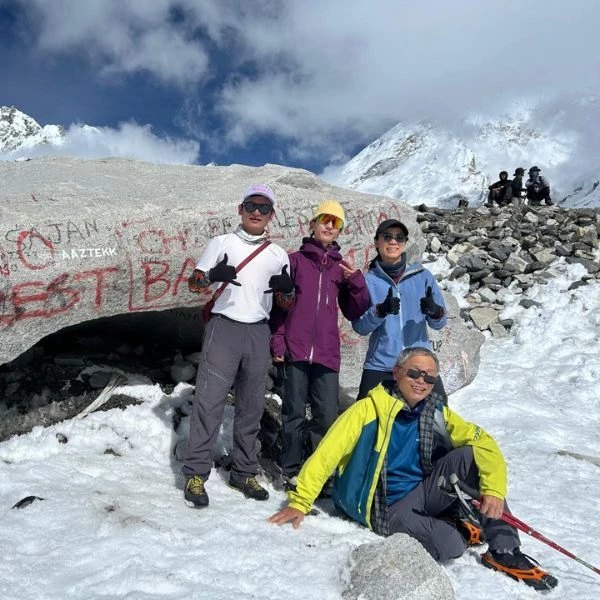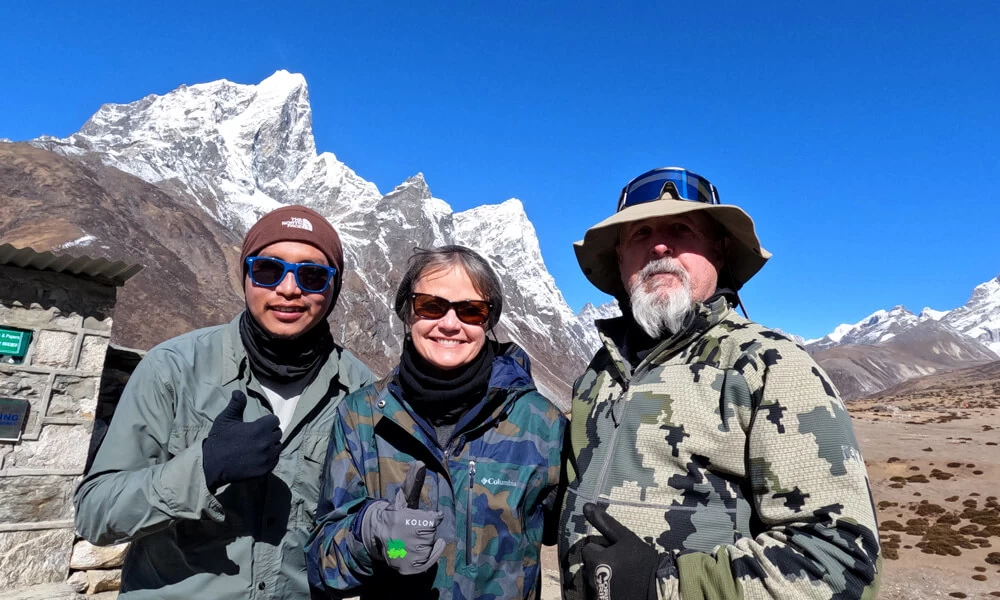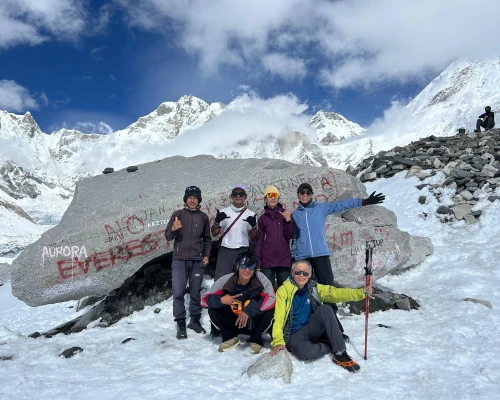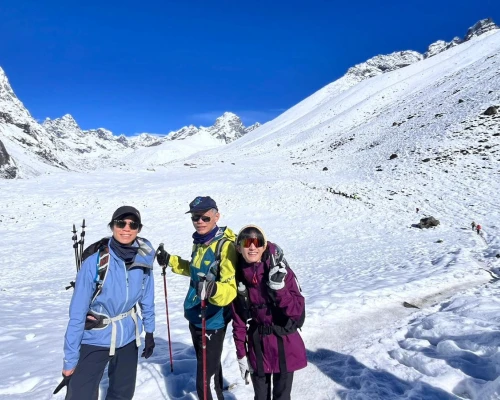Introduction of the 12 Days Base Camp Trek
The 12-day Everest Base Camp Trek is the ultimate Himalayan adventure for those craving altitude, epic views, and a real sense of the environment. This legendary trail takes you to Everest Base Camp (5,364m), deep in Nepal’s Khumbu region, and trust us, every step feels like magic. You will be walking through jaw-dropping landscapes, iconic Sherpa villages from the moment you land in Lukla. It’s an experience you will carry forever.
Your journey starts with a flight from Kathmandu to Lukla, hands down one of the most scenic (and thrilling) flights in the world. From there, it’s all legs and lungs. For the next 12 days, you will hike through lush pine forests, crossing swaying suspension bridges, visit age-old monasteries, and pass through heartwarming Sherpa villages. It’s designed smartly, with the right pace for acclimatization, so your body adjusts as the altitude climbs.
As you walk, the views are straight out of a movie, think Everest, Lhotse, Nuptse, and the ever gorgeous Ama Dablam right in front of you. It’s a proper trek, sure, you will walk 5 to 7 hours most days, but it’s absolutely doable with average fitness and a bit of grit.
And then there’s the people. The Sherpa hospitality, the cozy teahouses, the chants echoing from Tengboche Monastery, the cheerful chaos of Namche bazaar, and the peaceful stillness as Kala Patthar’s sunrise, it’s these real, raw moments that make the journey unforgettable. Want all the juicy details? Check out the full Everest Base Camp Trek Guide.
Is the 12-Day Everest Base Camp Trek Right for You?
Let's keep it real, this trek isn't just some easy nature walk. But it's also not only for super-fit mountaineers or people training for the Everest summit. If you are someone who stays reasonably active (think morning jogs, gym sessions, or weekend hikes), and you have got the kind of mindset that says “I got this” even when it gets tough, you’re honestly good to go.
You don't need to have done a crazy high-altitude expedition before. Loads of people do this as their first real trek. Sure, if you have done a few long hikes before, that helps, but you don't need to be a pro. It’s more about mental stamina than technical skill.
Altitude is the one thing you do need to respect. Once you are over 3000 meters, your body starts to feel it, and by the time you're up at Kala Patthar (5,545m), you will know you are high. But don't stress, the itinerary is built smart, with rest and acclimatization days baked in so your body can catch up. Drink water, go slow, and don't push through if your body’s saying, “hold up.”
As for age? It’s not a number thing. We have seen young teens, fit folks in their 70s, and all kinds of travelers take this on; solo, in couples, in groups. If your health checks out and your heart’s in it, you are already halfway there. Heads up: Altitude sickness is real. Definitely check out our Altitude Sickness Prevention Tips before you go.
Trek Difficulty and Acclimatization Plan
Okay, so how hard is the trek, really? Here’s the truth: it’s not easy, but it’s not some brutal sufferfest either. Think of it like this: it’s totally doable if you are fit, patient, and okay with pushing yourself a bit. Most of the trail is well trodden, with a mix of stone paths, dirt trails, and yes, some steep climbs here and there.
The good news? This 12-day plan isn't rushed. You will get two full acclimatization days, usually in Namche and Dingboche. Where you stay put and take short hikes to help your body adjust. This is super important; skipping acclimatization is how people end up miserable or worse.
The key here is pace. Seriously. Don't race ahead, don't try to be a hero. Just find your rhythm, enjoy the views, and take breaks whenever you need to. You will probably be walking around 5-7 hours a day, but it’s chill as long as you don't overdo it.
Also, hydrate like a camel. Water is your best friend up there. The more you drink, the better you handle the altitude. Skip the beer (even if that Namche bar looks tempting), and save the celebration for when you are back in Kathmandu. Trust us on this. Want to get your body ready before the trek? Don't miss our Acclimatisation Tips.
Cost Breakdown of the 12-Day Trek
Let’s talk money because planning your dream adventure without knowing the cost is a mistake. Not the right move. The 12-day Everest Base Camp Trek can vary a lot depending on how you want to do it, whether it is guided or independent. So, what is the total cost?
- Guided trek package: Usually ranges from $1,100 to $1,500 USD, all inclusive (permits, guide, porter, meals, lodging, Lukla flights, etc)
- Independent trek: Can go as low as $700-$900 USD, but you will have to sort everything yourself, including permits, flights, lodging, and more.
Permits? Yep, you will need these:
- Sagarmatha National Park Entry Permit: Around $30 USD
- Khumbu Pasang Lhamu Rural Municipality permit: Around $20 USD
Flights (Kathmandu to Lukla and back):
- Expect around $150-$200 USD each way, so $300-$400 total depending on season and booking time.
Guide and Porter Costs:
- Licensed guide: Around $25-$35 per day
- Porter: About $20- $25 per day
If you are not into carrying 10 kg on your back every day, trust us, a porter is worth every cent.
Food and Lodging:
- Lodging in teahouses: Around $5-$10/night
- Meals per day: $20-$30 total, depending on what and where you eat (yes, a plate of dal bhat at 4,000m does cost more than in Kathmandu).
Optional add-ons :
- Gear rental (sleeping bag, down jacket, etc): $1-$2 per item/day in Thamel
- Travel insurance( with high altitude coverage): $100-$150 for 2 weeks
- Hot showers, Wifi, and charging: Not always free. Budget $1-$5/ day for “comforts”
Want to dive deeper into the budget planning? Check out our full Everest Trek Cost Guide.
Guided vs Independent Trekking – Which Is Better for 12 Days?
Alright, so you know the cost. Now, let’s figure out how you want to roll: guided or independent? Both options have their own vibe, and the right choice really depends on your travel style. If you are all about ease, structure, and support, a guided trekis 100% worth it. But if you are the kind of traveler who likes figuring things out on the fly (and doesn't mind a bit of extra work), going independently might feel more your style.
The Pros of going on a guided trek are:
- You don't have to worry about logistics (permits, bookings, routes)
- Local guides give you insights you won't find on Google
- You get backup if anything goes sideways: weather, altitude issues, etc.
- Porters: less stress on your body
Cons:
- Slightly more expensive
- Less “ off the grid” flexibility.
For a 12-day EBC trek, guided treks are honestly the most time-efficient and stress-free option if it’s your first time in Nepal.
Going Solo (Independent Trekking):
Pros:
- You get to set your own pace, pause where you like, and just vibe with nature.
- It’s cheaper overall.
Cons:
- You have to organize everything (permits, flights, teahouse, etc.)
- If something goes wrong, you are kind of on your own
- Altitude-related issues are harder to manage without help
You can't trek completely solo anymore in most parts of Nepal, including the Everest region; a registered guide is required even for independent travelers. So that “ true solo” vibe? Not really allowed. Need help choosing a solid tour provider? Check our picks for the Best Trekking Agencies for the Everest Trek.
How to Book the 12-Day Everest Base Camp Trek?
Ready to lock it in? Booking your 12-day Everest base camp Trek is actually pretty straightforward, but knowing your options helps big time. You can book online in advance through a trekking agency (super convenient ), or wait until you arrive in Kathmandu and shop around in Thamel. Booking online gives you more time to research and read reviews, and you can usually chat with the company beforehand to customize your trek.
Most Everest Base Camp 12-day trek packages include your permit, guide, porter, and domestic flights (Kathmandu- Lukla). Accommodation and meals on the trip. Some also throw in extras like airport pickup, gear rental, or even a city tour, so read the fine print.
And yep, always check the cancellation and refund policy, especially with unpredictable things like Lukla flights or political strikes. Want help booking your trek? Hit up our Everest Trek Booking Page or just contact us because we are here to help.

.webp)



.webp)
.webp)

.webp)
.webp)

.webp)
.webp)